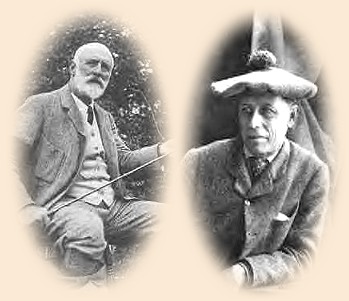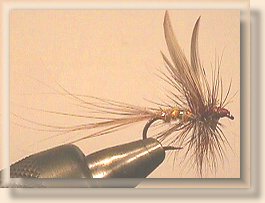Last time I wrote an article titled "Thinking Outside the Box."
This is a continuation on that theme, but going from the past to the present to
illustrate the idea.
Dry flies first came into existence about 1850. Foster, of Cheltenham
England sold split wing flies, that were claimed to be, upright and floating.
But either due to the equipment of that day, or the construction of the flies,
most would end up on their sides.
It took another 40 years for dry flies to take in the fly angling community,
and the repercussions are still felt to this day. There is a divided house
between the dry fly and the wet fly enthusiasts.
The person or should I say persons, who started it all was Frederick M.
Halford (shown on the left below) and his friend George S. Marryat,
(on the right).

They met in 1879, and with George S. Marryats help, Frederick M. Halford
wrote Floating Flies and How to Dress Them in 1886.
They described flyfishing as ".... representing to the rising fish the best possible
imitation of the insect on which he is feeding in its natural position."
F. M. Halford set down five conditions for a dry fly:
1) Finding a fish feeding on winged insects.
2) Presenting to him a good imitation of the natural insect both as to size and
color.
3) Presenting it to him in its natural position, floating, and cocked.
4) Putting it lightly on the water so that it floats accurately over him without drag.
5) The four previous points should have been fulfilled before the fish has caught sight
of the angler and his rod.
After the first book F. M. Halford wrote; Dry Fly Fishing in Theory published 1889,
Making a Fishery, published 1895, Dry Fly Entomology published 1897,
Modern Development of the Dry Fly published 1910 and The Dry Fly Man's
Handbook published 1913.
Of all the dry flies F. M. Halford created, few if any are still, used today.
Yet his influence carried over to America with his correspondence with
Theodore Gordon. Theodore Gordon is regarded by many to have started
the American Dry Fly school in New York State.
It is a shame the only fly we use today (that I know of) in America, that derived
from F. M. Halford, is the "Golden Ribbed Hares-Ear." It started off as a dry fly,
evolved into a wet fly, and ended up a nymph pattern.
Here is the recipe that I came across a few years ago, reportedly attributed to
F. M. Halford, for his "Golden Ribbed Hares-Ear" dry fly.

Hook: Standard Dry Fly (Size 14-18).
Thread: Brown 6/0.
Wing: Pale Starling (I used natural gray mallard wing),
tied as Halford Basket Wings. (See Tying Tip:
Halford Wing
in the the archives.
Tail: Mixture of Brown and Grizzly, rooster hackle.
Ribbing: Thin Golden Tinsel.
Body: Brown Rabbit Dubbing.
Hackle: Brown & Grizzly Hackle.
Except for the material for the wing method and the body, it would be the pattern recipe
for the Adams. And there is the connection, from the past to the present!
I would like to thank Dr. Andrew N. Herd, who was kind enough to give me
permission to use the materials and photos from his
Fly Fishing History Internet site for this article. Please visit Fly Fishing
History, https://www.flyfishinghistory.com it is a terrific site.
Now for the answer to last weeks quiz titled "Johnny's Mother:"
The answer is Johnny!
The winner of a fly tin of F. M. Halford's "Golden Ribbed Hares Ear" dry flies is:
Tom Ito
Please check out the Fly Tying Section, on the
Bulletin Board, on FAOL too.
If you have any questions, tips, or techniques; send them along.
Someone else thought up most of this material before we did,
they just forgot to tell anyone about it. Or else we just
forgot about it, while learning something else. Let us
share with each other, all the things we know!
~ Steven H.
McGarthwaite (Chat Room AKA Parnelli)
|





